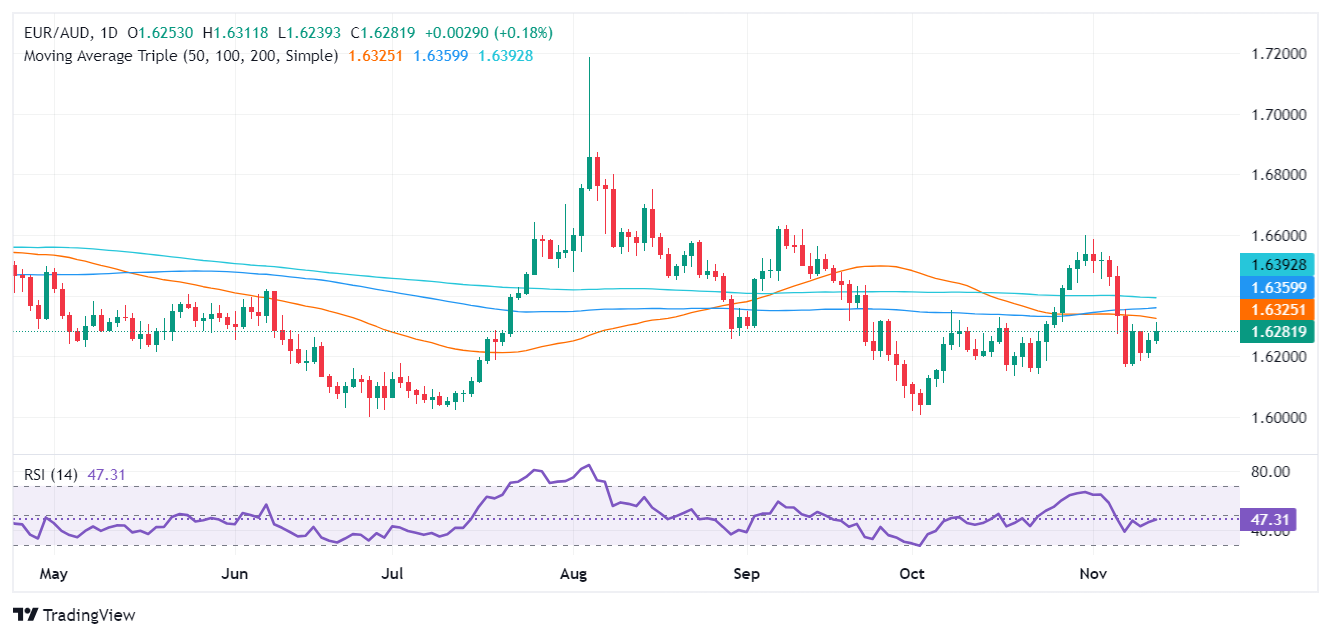EUR/AUD Price Forecast: Climbs as traders eye 1.6300 and await Aussie jobs data
- EUR/AUD recovers from daily lows, and traders await the October job report in Australia.
- Technical stance shows EUR/AUD near key support; a drop below 1.6238 could target 1.6200 and lower supports.
- Upside potential exists with resistance at 50-day, 100-day, and 200-day SMAs at 1.6315, 1.6356, and 1.6386 respectively.
The shared currency stages a recovery against the Aussie Dollar on Wednesday, printing gains of over 0.18%, as traders await Australia’s job report. At the time of writing, the EUR/AUD trades at 1.6284 after hitting a daily low of 1.6238.
The Australian Bureau of Statistics (ABS) will reveal employment figures for October. The Employment Change is estimated to have created 25K jobs, below September’s outstanding 64.1K, with the Unemployment Rate expected to remain at 4.1%.
EUR/AUD Price Forecast: Technical outlook
The EUR/AUD is neutral to downward biased after the cross plunged below the 200, 100, and 50-day Simple Moving Averages (SMAs), within a confluence zone at around 1.6315/86. Although the exchange rate aimed higher during the last three days, a drop below the November 13 low of 1.6238 could pave the way for 1.6200. A breach of the latter will expose intermediate support at 1.6161, the latest cycle low reached on November 7, followed by the year-to-date (YTD) low of 1.6003.
Conversely, on further EUR/AUD strength, buyers must clear the 50-day SMA at 1.6315. If surpassed, up next would be the 100-day SMA at 1.6356, followed by the 200-day SMA at 1.6386. Once surpassed, the following resistance would be the 1.6400 figure.
EUR/AUD Price Chart – Daily

Australian Dollar FAQs
One of the most significant factors for the Australian Dollar (AUD) is the level of interest rates set by the Reserve Bank of Australia (RBA). Because Australia is a resource-rich country another key driver is the price of its biggest export, Iron Ore. The health of the Chinese economy, its largest trading partner, is a factor, as well as inflation in Australia, its growth rate and Trade Balance. Market sentiment – whether investors are taking on more risky assets (risk-on) or seeking safe-havens (risk-off) – is also a factor, with risk-on positive for AUD.
The Reserve Bank of Australia (RBA) influences the Australian Dollar (AUD) by setting the level of interest rates that Australian banks can lend to each other. This influences the level of interest rates in the economy as a whole. The main goal of the RBA is to maintain a stable inflation rate of 2-3% by adjusting interest rates up or down. Relatively high interest rates compared to other major central banks support the AUD, and the opposite for relatively low. The RBA can also use quantitative easing and tightening to influence credit conditions, with the former AUD-negative and the latter AUD-positive.
China is Australia’s largest trading partner so the health of the Chinese economy is a major influence on the value of the Australian Dollar (AUD). When the Chinese economy is doing well it purchases more raw materials, goods and services from Australia, lifting demand for the AUD, and pushing up its value. The opposite is the case when the Chinese economy is not growing as fast as expected. Positive or negative surprises in Chinese growth data, therefore, often have a direct impact on the Australian Dollar and its pairs.
Iron Ore is Australia’s largest export, accounting for $118 billion a year according to data from 2021, with China as its primary destination. The price of Iron Ore, therefore, can be a driver of the Australian Dollar. Generally, if the price of Iron Ore rises, AUD also goes up, as aggregate demand for the currency increases. The opposite is the case if the price of Iron Ore falls. Higher Iron Ore prices also tend to result in a greater likelihood of a positive Trade Balance for Australia, which is also positive of the AUD.
The Trade Balance, which is the difference between what a country earns from its exports versus what it pays for its imports, is another factor that can influence the value of the Australian Dollar. If Australia produces highly sought after exports, then its currency will gain in value purely from the surplus demand created from foreign buyers seeking to purchase its exports versus what it spends to purchase imports. Therefore, a positive net Trade Balance strengthens the AUD, with the opposite effect if the Trade Balance is negative.

